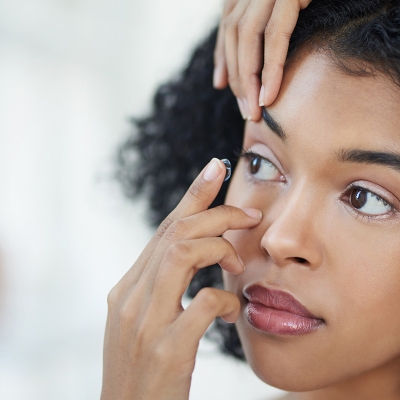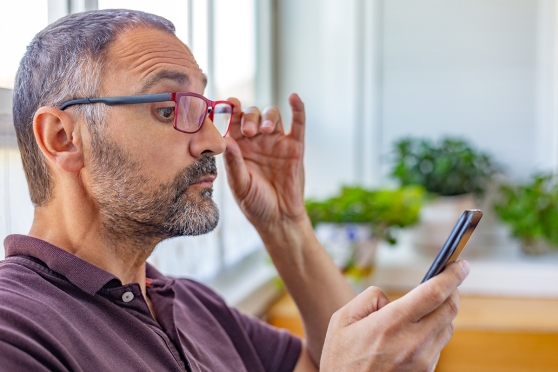What to know about age-related macular degeneration
This eye disease is more common in older adults. Learn what it is — and what may be done to keep your vision safe.

As people get older, it’s normal for their vision to change. It might be harder to read the newspaper or a restaurant menu.1 (That’s thanks to presbyopia, a natural age-related eye condition that happens to everyone.) It may even be tougher to tell the difference between colors like blue and black.1
Severe vision loss, on the other hand, is not an inevitable part of aging. It could point to a serious eye disease, such as age-related macular degeneration (AMD). AMD is a leading cause of vision loss in people ages 50 and older.2 In 2019, an estimated 19.8 million Americans ages 40 and older were living with AMD.3
“Early macular degeneration often doesn’t have any symptoms,” says Chantal Cousineau-Krieger, M.D., an ophthalmologist at the National Eye Institute.4 During an eye exam, though, an eye doctor may spot early warning signs, and allow time to take steps that may slow the progression of the disease. Detecting AMD early may even help prevent vision loss.
That’s why it’s “critical” that you keep up with regular eye exams, says Dr. Cousineau-Krieger.
Here’s what to know about AMD to help protect your vision and eye health.
Stay on top of your eye health with an in-network provider. Search for an eye care provider now.
What is age-related macular degeneration?
AMD is an eye disease that may blur people’s central vision (what is seen while looking straight ahead). AMD harms vision by damaging a part of the retina called the macula. (The retina is the light-sensitive tissue at the back of the eye. The macula controls sharp and straight-ahead vision.4)
“We develop little protein waste deposits underneath the retina, and they can cause loss of retina tissue or abnormal blood vessels to develop,” says Dr. Cousineau-Krieger.
What are the different types of AMD?
There are two kinds of AMD: dry AMD and wet AMD.
Dry AMD is the most common form of AMD. About 8 out of 10 people who have AMD have the dry form.2
With dry AMD, parts of the macula get thinner with age. Clumps of protein, called drusen, grow beneath the retina. That slowly causes a loss of central vision.2
- Wet AMD is a form of AMD that’s less common. It’s also more serious.
“The wet form is typically the form that causes more rapid loss of vision,” says Abdhish R. Bhavsar, M.D., a spokesperson for the American Academy of Ophthalmology. “The dry form usually causes slower loss of vision. But they both can cause loss of vision over time.”
With wet AMD, new and abnormal blood vessels grow under the retina. The blood vessels may leak fluid, scarring the macula. Vision loss typically happens faster with wet AMD.2
What are the symptoms of AMD?
AMD’s symptoms typically get worse over time. Dry AMD happens in 3 stages:4
- Early stage
- Intermediate stage
- Late stage
Symptoms of AMD depend on the stage of the disease:4
- Early AMD doesn’t cause symptoms.
- Intermediate AMD may cause blurry central vision or trouble seeing in low lighting. But it may have no symptoms.
- With late AMD, people begin to experience blurry central vision. Patients often describe straight lines seeming to appear wavy or crooked.
Over time, the blurry area may get bigger, or blank spots may be visible. Colors may also look less vibrant.4
To keep track of how AMD symptoms are progressing, Dr. Bhavsar suggests using something called an Amsler grid. It’s a simple square containing a grid pattern with a dot in the middle.2
If any of the lines appear wavy, distorted or faded, it may be a sign of AMD. Another sign: If any parts of the grid appear to be missing. An Amsler grid may help uncover problem spots in your field of vision when used once a day, every day.5
Dr. Cousineau-Krieger says AMD may make it hard to do daily activities, including:
- Driving
- Identifying faces
- Reading
Who is at risk of AMD?
People ages 55 and older are more likely to develop AMD.2, 4 Other AMD risk factors include:2, 4
- A diet high in saturated fat
- Being Caucasian
- Being overweight
- Having a family history of AMD
- Having high blood pressure
- Smoking cigarettes
How do doctors diagnose AMD?
An eye doctor may check for AMD during a dilated eye exam. Eye doctors will use special eye drops to dilate (enlarge) the pupils.4 That lets them see the entirety of the eye, including the back of the eyes.
Eye doctors may also check your eyes for signs of AMD in these ways:2
- An optical coherence tomography test. They’ll use a machine to scan the retina and look at images of the retina and macula.
- A fluorescein (yellow dye) angiography. They’ll inject yellow dye into a vein, usually in an arm. The dye goes through the blood vessels and eventually reaches the eyes. Then they’ll use a special camera to take pictures of the retina, which may show a doctor if abnormal blood vessels are growing under the retina.
How do doctors treat AMD?
Treatment of AMD depends on the type and stage of it.4
For people with wet AMD, doctors may use the following treatments to help stop further vision loss:4
- Anti–vascular endothelial growth factor (anti-VEGF) drugs. These medicines may help slow the growth of abnormal blood vessels in the retina. The eye doctor injects the medicine into the eye.
- Photodynamic therapy. This is a combination of injections and laser treatment.
People may ask their eye doctor which treatment is the best fit for them.
Currently, there is no treatment for dry AMD.2 But a special combination of vitamins and minerals may help people with lots of buildup of protein under the retina (drusen) or serious vision loss.2 The vitamin and mineral combination includes:2
- Copper
- Lutein
- Vitamin C
- Vitamin E
- Zeaxanthin
- Zinc
Is AMD preventable?
People may make some simple lifestyle changes to help lower their risk of AMD. According to Dr. Cousineau-Krieger, these include:
- Eating leafy greens and colorful fruits and vegetables
- Keeping blood pressure at a healthy level
- Losing weight, if needed
- Quitting smoking
Living with AMD may be easier with the right help. If diagnosed with AMD, speak with an eye doctor about resources and services that may help with low vision, including:2
- Handheld computers
- Magnifying tools
- New technologies
- Rehab services
Providers in the UnitedHealthcare Vision Network are here to help keep your vision healthy. Search for an eye care provider now.
Sources:
- Aging and your eyes National Institute on Aging, last reviewed July 2021. Accessed November 7, 2023.
- What is macular degeneration? American Academy of Ophthalmology, April 2023. Accessed November 7, 2023.
- Prevalence of age-related macular degeneration (AMD) Centers for Disease Control and Prevention, last reviewed October 2022. Accessed November 7, 2023.
- Age-related macular degeneration (AMD) National Eye Institute, last updated June 2021. Accessed November 7, 2023.
- Have AMD? Save your sight with an Amsler grid American Academy of Ophthalmology, May 2023. Accessed November 7, 2023.


